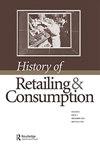The corset and the mirror. Fashion and domesticity in Swedish advertisements and fashion magazines, 1870–1914
Q2 Arts and Humanities
引用次数: 7
Abstract
ABSTRACT The article discusses two elusive components in the construction of bourgeois and middle class femininity in Sweden, 1870–1914: the corset and the mirror. Two popular genres of images are contrasted: images of corsets in Swedish fashion advertisements, and images of corsets and undergarments in Swedish fashion magazines. While fashion advertisements in general copied fashion magazine images, they chose a different path in regard of the corset and the mirror. The two objects, albeit important parts of the period’s fashion, are made invisible in fashion magazines while clearly visualized in the advertisements. The purpose of Swedish fashion magazines was not only to present the latest fashion, but also to construct a conception of timeless womanhood well integrated into the predominant ideology of domesticity. Vanity, gossip, and erotic desires were staple goods of traditional misogyny and were hardly possible to express in fashion magazines. Advertising on the other hand communicated with the female consumer as an individual and presented her as a vain, sexual and emotional creature – without condemning her at the same time. Fashion advertisements emancipated, clearly not woman, but fashion itself, from the morals of domesticity.紧身胸衣和镜子。1870-1914年瑞典广告和时尚杂志中的时尚与家庭生活
本文讨论了1870-1914年瑞典资产阶级和中产阶级女性气质建构中两个难以捉摸的组成部分:紧身胸衣和镜子。对比了两种流行的图像类型:瑞典时尚广告中的紧身胸衣图像和瑞典时尚杂志中的紧身胸衣和内衣图像。虽然时尚广告一般都是模仿时尚杂志的形象,但他们在紧身胸衣和镜子方面选择了不同的道路。这两件物品虽然是那个时期时尚的重要组成部分,但在时尚杂志上却看不见,而在广告中却清晰可见。瑞典时尚杂志的目的不仅是呈现最新的时尚,而且要构建一种永恒的女性观念,与主流的家庭生活意识形态完美结合。虚荣、八卦和情欲是传统厌女症的主要内容,几乎不可能在时尚杂志上表达出来。另一方面,广告将女性消费者作为一个个体进行沟通,并将她们呈现为一个虚荣、性感和感性的生物——同时却没有谴责她们。时尚广告显然不是把女人,而是把时尚本身,从家庭生活的道德中解放出来。
本文章由计算机程序翻译,如有差异,请以英文原文为准。
求助全文
约1分钟内获得全文
求助全文
来源期刊

History of Retailing and Consumption
Arts and Humanities-History
CiteScore
0.50
自引率
0.00%
发文量
3
 求助内容:
求助内容: 应助结果提醒方式:
应助结果提醒方式:


